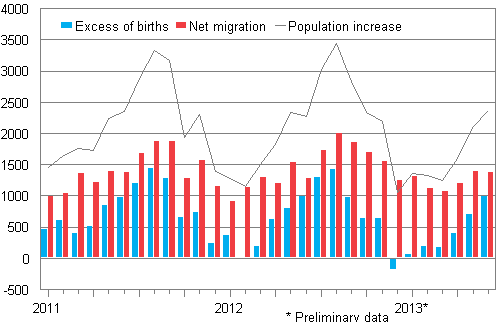Published: 23 July 2013
Finland's preliminary population figure 5,436,678 at the end of June
According to Statistics Finland's preliminary data, Finland's population at the end of June was 5,436,678. Over the January to June period, Finland's population increased by 10,000 persons, which is 340 less than in the respective period of one year previously. The main reason for the population increase was migration gain from abroad: the number of immigrants was 7,480 higher than that of emigrants. Natural population growth, or excess of births to deaths, was 2,520 persons.
Population increase by month 2010–2013*

According to the preliminary statistics for January to June period, 13,200 persons immigrated to Finland from abroad and 5,720 persons emigrated from Finland. The number of immigrants was 290 and the number of emigrants 410 lower than in the corresponding period of the previous year. In all, 3,820 of the immigrants and 3,920 of the emigrants were Finnish citizens.
During the first half-year period, 29,020 children were born, which is 620 fewer than in the corresponding period of 2012. The number of deaths decreased by 150 from the year before and amounted to 26,500.
According to the preliminary data, the number of inter-municipal migrations totalled 117,890 by the end of June. Compared with the previous January to June period, the decrease was 5,040 migrations according to the municipal division of 2013.
According to preliminary data by region, the population grew in ten regions and decreased in nine regions in the January to June period. Both the natural population development and total net migration were positive in Uusimaa, Pirkanmaa, Central Ostrobothnia, and in Åland. In Lapland, Kainuu, North and South Karelia, and in North Savo both the natural population development and total net migration were negative.
In the January to June period, the population grew most in absolute numbers in Uusimaa, where the population grew by 9,290 persons. Pirkanmaa had the second-largest population growth, 1,190 persons. Relative to the population, population increase was highest in the regions of Uusimaa and Åland, with relative growth figures of 5.9 and 5.1 per mil, respectively. Population loss was highest in absolute numbers in the region of Lapland that lost 630 persons. The population of South Savo decreased by 420 persons, which was the second most. In relative terms, the population loss was largest in the region of Lapland that lost 3.5 per mil of its population. Kainuu's relative population loss was closest to the figure of Lapland at -2.9 per mil.
The relative population growth speeded up most in Kainuu and Varsinais-Suomi in the January to June period. However, the population loss in Kainuu was 2.9 per mil, but in the corresponding period of last year population loss was even higher, 3.7 per mil. The relative population growth in Varsinais-Suomi was 1.3 per mil in January to June, increasing by 0.6 per mil units from the relative population growth in the corresponding period in 2012.
According to preliminary data, relative population growth slowed down most in Åland and in Lapland. In Åland, the relative population increase was 5.1 per mil in the first half of the year, having been 6.7 per mil in the previous year. In Lapland, the relative population increase was -3.5 per mil, decreasing by 1.2 per mil units from the year before.
Most migration gain in relative terms from intermunicipal and international migration in January to June was collected by Åland and Uusimaa. Åland's migration gain was 4.3 and Uusimaa's 4.0 per mil according to the municipal division of 2013. Migration loss was largest in relative terms in the regions of Lapland and Central Finland. The relative migration losses of Lapland and Central Finland were 2.9 and 1.9 per mil, respectively.
Urban travel-to-work areas gained 800 persons in intermunicipal migration during the first half of the year, while the gain in the corresponding time period last year was 350 persons. Statistics is based on urban regions classification of population statistics. The migration loss of central municipalities was 80 persons, while it was 1,720 persons one year ago. Satellite municipalities had a migration gain of 880 persons in January to June, decreasing by 1,190 persons from the year before.
Source: Population and Cause of Death Statistics. Statistics Finland
Inquiries: Matti Saari 09 1734 3401, Irma Pitkänen 09 1734 3262
Director in charge: Riitta Harala
Publication in pdf-format (298.9 kB)
- Tables
-
Tables in databases
Pick the data you need into tables, view the data as graphs, or download the data for your use.
Appendix tables
- Appendix table 1. Preliminary data on vital statistics by month of occurence 2013 (23.7.2013)
- Appendix table 2. Vital statistics, final data 2005 - 2012 and preliminary data 2013* (23.7.2013)
- Appendix table 3. Comparison between preliminary vital statistics in 2013 and 2012 (23.7.2013)
- Appendix table 4. Preliminary vital statistics by region 2013 and change compared to 2012 preliminary data, quarter 1 - 2 (23.7.2013)
- Appendix table 5. Preliminary data by region on immigrants and emigrants according to country of departure/destination 2013, quarter 1 - 2 (23.7.2013)
- Figures
-
- Appendix figure 1. Live births by quarter 1993 - 2012 and preliminary data 2013 (23.7.2013)
- Appendix figure 2. Deaths by quarter 1993 - 2012 and preliminary data 2013 (23.7.2013)
- Appendix figure 3. Intermunicipal migration by quarter 1993 - 2012 and preliminary data 2013 (23.7.2013)
- Appendix figure 4. Immigration by quarter 1993 - 2012 and preliminary data 2013 (23.7.2013)
- Appendix figure 5. Emigration by quarter 1993 - 2012 and preliminary data 2013 (23.7.2013)
Updated 23.7.2013
Official Statistics of Finland (OSF):
Preliminary population statistics [e-publication].
ISSN=2243-3627. June 2013. Helsinki: Statistics Finland [referred: 21.12.2025].
Access method: http://stat.fi/til/vamuu/2013/06/vamuu_2013_06_2013-07-23_tie_001_en.html

